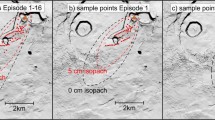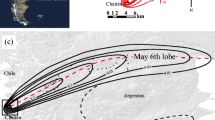Abstract
Studies of grain-size distributions of explosive volcanic eruptions provide important insights into fragmentation mechanisms and eruptive conditions and are crucial to the modeling of tephra dispersal. As a result of sedimentation processes and plume dynamics, grain-size features vary significantly both in the downwind and crosswind directions and are difficult to characterize. We have analyzed grain-size features in the downwind and crosswind directions of the two largest eruptions of the last 2000 years of Cotopaxi volcano activity (Ecuador). Crosswind grain-size variations are similar for both eruptions (i.e., layers 3 and 5), while at any given downwind distance from vent, the layer 3 deposit is coarser than the layer 5 one. This suggests that layers 3 and 5 were characterized by similar plume height but that layer 3 was advected by a stronger wind. In addition, both deposits are coarsest along the dispersal axis and become richer in ash in the crosswind direction showing a Gaussian decreasing rate. Deposit thickness also shows a Gaussian crosswind decay, but layer 3 is significantly thicker at all points than is layer 5 due to the former's larger erupted mass. Based on both quantitative analysis of field data and on numerical simulations, we show that tephra deposits associated with large explosive eruptions (i.e., plume height of 30 km) should be sampled out to at least 200 km from the vent (depending on wind speed and tropopause height) in order to derive complete grain-size distributions that are not depleted in fines. Eruptions occurring in a strong wind field at high latitudes (e.g., Iceland) require lesser representative-sampling distances because of the lower tropopause heights.









Similar content being viewed by others
References
Barberi F, Coltelli M, Frullani A, Rosi M, Almeida E (1995) Chronology and dispersal characteristics of recently (last 5000 years) erupted tephra of Cotopaxi (Ecuador): implications for long-term eruptive forecasting. J Volcanol Geotherm Res 69(3- 4):217–239
Biass S, Bonadonna C (2011) A quantitative uncertainty assessment of eruptive parameters derived from tephra deposits: the example of two large eruptions of Cotopaxi volcano, Ecuador. Bull Volcanol 73:73–90
Bonadonna C, Costa A (2013) Modeling of tephra sedimentation from volcanic plumes. In: Fagents SA, Gregg TKP, Lopes RMC (eds) Modeling volcanic processes: the physics and mathematics of volcanism. Cambridge University Press, CAMBRIDGE, pp 173–202. ISBN 9780521895439
Bonadonna C, Houghton BF (2005) Total grain-size distribution and volume of tephra-fall deposits. Bull Volcanol 67:441–456
Bonadonna C, Phillips JC (2003) Sedimentation from strong volcanic plumes. J Geophys Res 108(B7):2340–2368
Bonadonna C, Biass S, Costa A (2015) Physical characterization of explosive volcanic eruptions based on tephra deposits: propagation of uncertainties and sensitivity analysis. J Volcanol Geothermal Res 296:80–100
Brown R, Bonadonna C, Durant A (2012) A review of volcanic ash aggregation. Phys Chem Earth 45–46:65–78
Bursik MI, Sparks RSJ, Gilbert JS, Carey SN (1992) Sedimentation of tephra by volcanic plumes: I. Theory and its comparison with a study of the Fogo A plinian deposit, Sao Miguel (Azores). Bull Volcanol 54:329–344
Carey SN, Sigurdsson H (1982) Influence of particle aggregation on deposition of distal tephra from the May 18, 1980, eruption of Mount St. Helens volcano. J Geophys Res 87(B8):7061–7072
Carey S, Sparks RSJ (1986) Quantitative models of the fallout and dispersal of tephra from volcanic eruption columns. Bull Volcanol 48:109–125
Carey RJ, Houghton BF, Thordarson T (2010) Tephra dispersal and eruption dynamics of wet and dry phases of the 1875 eruption of Askja volcano, Iceland. Bull Volcanol 72:259–278
Connor LJ, Connor CB (2006) Inversion is the key to dispersion understanding eruption dynamics by inverting tephra fallout. In: Mader HM, Connor CB, Coles SG, Connor LJ (eds) Statistics in volcanology special publications of IAVCEI, 1. Geological Society, London, pp 231–242
Costantini L (2010) Understanding basaltic explosive volcanism. PhD dissertation, Université de Genève, Switzerland
Eychenne J, Le Pennec J-L, Troncoso L, Gouhier M, Nedelec J-M (2012) Causes and consequences of bimodal grain-size distribution of tephra fall deposited during the August 2006 Tungurahua eruption (Ecuador). Bull Volcanol 74(1):187–205
Fierstein J, Nathanson M (1992) Another look at the calculation of fallout tephra volumes. Bull Volcanol 54(2):156–167
Folch A (2012) A review of tephra transport and dispersal models: evolution, current status, and future perspectives. J Volcanol Geotherm Res 235–236(1):96–115
Inman DL (1952) Measures for describing the size distribution of sediments. J Sediment Petrol 22:125–145
Kaminski E, Jaupart C (1998) The size distribution of pyroclasts and the fragmentation sequence in explosive volcanic eruptions. J Geophys Res 103(B12):29759–29779
Koyaguchi T, Ohno M (2001a) Reconstruction of eruption column dynamics on the basis of grain-size of tephra-fall deposits: part 1. Methods. J Geophys Res 106:6499–6512
Koyaguchi T, Ohno M (2001b) Reconstruction of eruption column dynamics on the basis of grain-size of tephra-fall deposits: part 2. Application to the Pinatubo 1991 eruptions. J Geophys Res 106:6513–6533
Mastin LG, Guffanti M, Servranckx R, Webley P, Barsotti S, Dean K, Durant A, Ewert JW, Neri A, Rose WI, Schneider D, Siebert L, Stunder B, Swanson G, Tupper A, Volentik A, Waythomas CF (2009) A multidisciplinary effort to assign realistic source parameters to models of volcanic ash-cloud transport and dispersion during eruptions. J Volcanol Geotherm Res 186:10–21
Murrow PJ, Rose WI, Self S (1980) Determination of the total grain size distribution in a Vulcanian eruption column, and its implications to stratospheric aerosol perturbation. Geophys Res Lett 7:893–896
Newhall CG, Self S (1982) The volcanic explosivity index (VEI) an estimate of explosive magnitude for historical volcanism. J Geophys Res 87:1231–1238
Parfitt E (1998) A study of clast size distribution, ash deposition and fragmentation in a Hawaiian-style volcanic eruption. J Volcanol Geotherm Res 84:197–208
Pyle DM (1989) The thickness, volume and grainsize of tephra fall deposits. Bull Volcanol 51(1):1–15
Schumacher R (1994) A reappraisal of Mount St. Helens ash clusters depositional model from experimental-observation. J Volcanol Geotherm Res 59(3):253–260
Sparks RSJ (1986) The dimensions and dynamics of volcanic eruption columns. Bull Volcanol 48:3–15
Sparks RSJ, Wilson L, Sigurdsson H (1981) The pyroclastic deposits of the 1875 eruption of Askja, Iceland. Philos Trans R Soc Lond 299:241–273
Van Eaton AR, Muirhead JD, Wilson CJN, Cimarelli C (2012) Growth of volcanic ash aggregates in the presence of liquid water and ice: an experimental approach. Bull Volcanol 74(9):1963–1984
Volentik ACM, Bonadonna C, Connor CB, Connor LJ, Rosi M (2010) Modeling tephra dispersal in absence of wind: insights from the climactic phase of the 2450 bp plinian eruption of Pululagua volcano (Ecuador). J Volcanol Geotherm Res 193(1-2):117–136
Walker GPL (1971) Grain-size characteristics of pyroclastic deposits. J Geol 79(6):696–714
Walker GPL (1980) The Taupo pumice: product of the most powerful known (ultraplinian) eruption? J Volcanol Geotherm Res 8:69–94
Walker GPL (1981a) Characteristics of two phreatoplinian ashes, and their water-flushed origin. J Volcanol Geotherm Res 9:395–407
Walker GPL (1981b) Plinian eruptions and their products. Bull Volcanol 44:223–240
Walker GPL (1981c) The Waimihia and Hatepe plinian deposits from the rhyolitic Taupo Volcanic Centre. N Z J Geol Geophys 24:305–324
Wilson L, Walker GPL (1987) Explosive volcanic eruptions—VI. Ejecta dispersal in Plinian eruptions: the control of eruption conditions and atmospheric properties. Geophys J R Astron Soc 89(2):657–679
Woods AW (1988) The fluid dynamics and thermodynamics of plinian eruption columns. Bull Volcanol 50:169–193
Acknowledgments
This project was supported by the Swiss National Science Foundation (No. 200021-116335). We thank Raffaello Cioni, Marco Pistolesi, Sebastien Biass, Licia Costantini, and Mauro Rosi for the support during our field work in Cotopaxi and Sebastien Biass also for his support during the writing phase of this manuscript. We appreciate three reviewers for their helpful comments and advices.
Author information
Authors and Affiliations
Corresponding author
Additional information
Editorial responsibility: M.L. Coombs
Rights and permissions
About this article
Cite this article
Tsunematsu, K., Bonadonna, C. Grain-size features of two large eruptions from Cotopaxi volcano (Ecuador) and implications for the calculation of the total grain-size distribution. Bull Volcanol 77, 64 (2015). https://doi.org/10.1007/s00445-015-0949-4
Received:
Accepted:
Published:
DOI: https://doi.org/10.1007/s00445-015-0949-4





